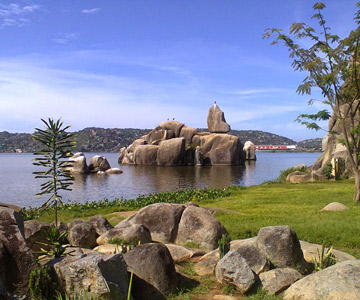
The tour takes more or less 2-3 hours on foot. The historical tour is mainly the relics of the periods of Germans, British, Indians and early Tanzania. The best starting point is the large roundabout or rotary near Lake Victoria (and near the Tourism Information Office =TIO) from where the three main roads are leading: to the East (Nyerere Road), to the South (Kenyatta Road), and to the airport in the North (Makongoro Road). Near the clock tower in the grass in middle of the roundabout is an inscription recalling that in 1858 the British explorer John Speke was the first European to see from nearby Isamilo Hill the waters of Nyanza which he called Lake Victoria after the reigning British Queen? He correctly claimed it to be the source of the river Nile. On the wall of the clock tower is a War Memorial of the British. During the First World War British troops coming from Kenya and Uganda drove out the German garrison of Mwanza who fled to Tabora to the south. The British administered Tanganyika up to 1961.
There are a number of monuments from the German Period, which lasted only from the early 1890s to 1916. Across the street in the direction of the lake are former German offices with a decorative small wall in front. Here criminals were condemned and hanged on the Gallows Tree, the trunk of which remains in the middle of the road to the East. On the hill to the east of Makongoro road, one can see a German Watch Tower which was part of a large fortress now used by the Regional Commissioner as his official residence. From there down to the lake there exists an underground tunnel (now closed). But in Balewa Street a deep well built entrance to the tunnel can be visited in the garden of a former German house. Along the way on the right one finds old German buildings.

At the roundabout one can see three monuments of early Tanzania: the Independence Torch, a mural painting on the wall of the Bank of Tanzania building in the style of Socialist Realism, and the CCM Building, the first skyscraper of Mwanza. Like Kirumba Sports Stadium it was built by all the residents of Mwanza less than One Party Rule. To the east of the roundabout lies the Indian Quarter of Mwanza. At the entrance of the Gandhi Hall stands a sculpture of the founder of modern India who lived for several years in South Africa. We read that the last British Governor of Tanganyika, Sir Edward Twining, opened the hall in 1957. On the inscription to the right, we read that it was built by Patels from Bombay or Mumbai who were then living in Mwanza. Many beautiful buildings constructed by Indians are still preserved. One can easily recognize them because of the symbols used by their Hindu and Moslem owners. In Bantu Street lies a Moslem building constructed in 1953 (Haji Mussa Mansion).